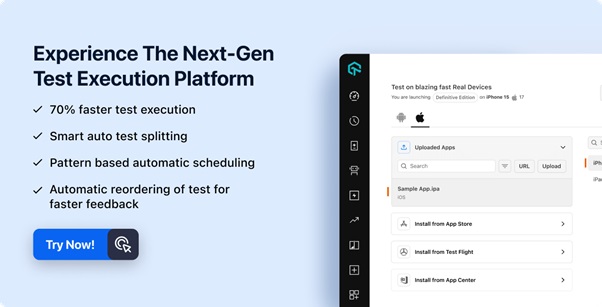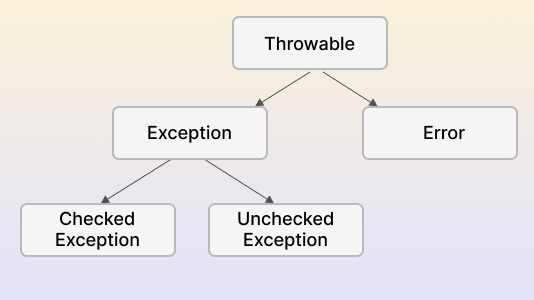In the arena of automation testing, Selenium is the most popular, free, and open-source framework used to run web application testing in web browsers such as,Google Chrome, Opera, Firefox, Edge and Safari. You can write Selenium IDE testing using multiple programming languages like Java, Python, Kotlin, JavaScript (Node.js), PHP, Ruby, and C#. While the benefits of selenium testing are endless, there are incidences of errors that happen often in the testing tool (or framework). When a program’s implementation is disturbed while run-time, an error is raised, preventing further instructions from being implemented.
Exceptions aren’t bad but are a fundamental section of modern programming. Rather than having a fear of exceptions, it is crucial to implement robust error handling and reporting mechanisms. Error handling is one of the critical facets of writing reliable and robust Selenium scripts. As automation QA testers, we often encounter unpredicted scenarios that can cause our scripts to fail. In this article, we’ll discuss various strategies and best practices for efficiently handling errors in Selenium scripts to enhance script reliability and maintainability.
Introduction to Errors and Exceptions in Selenium
Exception or error handling is a programming mechanism by which the incidence of errors and exceptions that halt the implementation of a program are responded to by the program to confirm the normal execution of code. Exceptions in Selenium Python are usually classified into two types.
- Unchecked Exceptions
- Checked Exceptions
Checked Exception in Selenium is conducted while writing the code. On the flip side, Unchecked Exceptions are raised during runtime and can create fatal errors compared to the former kind of exception.
The class hierarchy of error in Selenium
Understand Common Types of Errors
Before diving into error handling strategies, it is essential to recognize the common errors encountered in Selenium scripts. These comprise:
- NoSuchElementException: This occurs when WebDriver is unable to locate a component.
- ElementNotVisibleException: Arises when a component is present in the DOM but not visible.
- TimeoutException: Thrown when a command doesn’t complete in a particular time frame.
- NoSuchWindowException: This error happens if the window target to be switched doesn’t exist.
- StaleElementReferenceException: This Selenium error occurs when a component is no longer attached to the DOM.
- StaleElementReferenceException: This exception occurs when the web component is detached from the existing DOM.
- SessionNotFoundException: The WebDriver is acting after you leave the browser.
- TimeoutException: This happens when there isn’t adequate time for a command to be completed. For instance, the component searched was not found in the precise time.
- WebDriverException: It occurs whenever the WebDriver act right after you close the browser.
How to Effectively Handling Error in Selenium Scripts?
Effectively handling errors in Selenium scripts is vital for maintaining the stability and reliability of automation tests. To mitigate these issues, QA engineers require strong robust error-handling strategies.
By leveraging techniques, testers can gracefully manage errors, log meaningful error messages, and execute recovery actions when required. Additionally, implementing comprehensive logging mechanisms and using error-handling approaches can provide valuable insights into script failures and facilitate effective debugging. Let us best practices and strategies for competently handling errors in Selenium scripts, ensuring script maintainability.
1. Use Explicit Waits
Explicit waits are crucial to handle synchronization problems in Selenium scripts. WebDriverWait combined with ExpectedConditions allows scripts to wait for precise circumstances to be met before proceeding. This aids in mitigating component not found or timeout exceptions.
Example:
WebDriverWait wait = new WebDriverWait(driver, 10);
WebElement element = wait.until(ExpectedConditions.visibilityOfElementLocated(By.id(“elementId”)));
2. Execute Try-Catch Blocks
Encapsulate Selenium code within try-catch blocks to catch and handle errors or exceptions elegantly. This avoids abrupt script failures and offers a chance to log errors or execute recovery actions.
Example:
try {WebElement element = driver.findElement(By.id(“elementId”));element.click();} catch (NoSuchElementException e) { // Handle element not found exception System.out.println(“Element not found: ” + e.getMessage());}
3. Retry Mechanisms
For flaky tests or intermittent failures, applying retry mechanisms can be useful. Retry the failed deed a few times before marking the test as failed. This improves test stability, particularly in scenarios where failures are temporary.
Example:
int attempts = 0;
while (attempts < MAX_RETRY) { try {// Perform the action break;} catch (Exception e) {// Handle exception attempts++;}}
4. Multiple catch blocks
There are several forms of Exceptions, and you can expect more than one error from a single block of code. It aids you in handling every form of Exception separately with a distinct block of code. Multiple catches can be used for more than two catch blocks, and there is no restriction on the number of catch blocks.
Example:
try{//Code} catch (ExceptionType1 e1) {//Code for Handling Exception 1} catch (ExceptionType2 e2) {//Code for Handling Exception 2}
5. Logging
Execute robust logging mechanisms to capture bugs, debug information, and contextual data during script implementation. Utilize logging frameworks like java.util.logging or Log4j to log meaningful error messages and stack traces.
Example:
import java.util.logging.Logger;
Logger logger = Logger.getLogger(“SeleniumLogger”);
logger.info(“Element not found: ” + e.getMessage());
6. Handle Pop-ups and Alerts
Be prepared to handle browser alerts and pop-ups gracefully in Selenium scripts. Use alert handling methods or try-catch blocks to accept or dismiss alerts as per test needs.
Example:
try {Alert alert = driver.switchTo().alert(); alert.accept(); // Dismiss the alert} catch (NoAlertPresentException e) { // No alert present, continue with the test}
7. Throw
When you wish to create an Exception, the Throw keyword is utilized to throw an exception to handle it in the run time. While you are throwing an Exception without handling it, then they require you to use the Throw keyword.
Example:
public static void anyFunction() throws Exception{try {// write your code here} Catch (Exception b) {// Do whatever you want to perform// Throw the Exception back to the systemthrow(b);}}
8. Multiple Exceptions
You can mention multiple Exceptions in the throws clause.
Example:
public static void anyFunction() throws ExceptionType1, ExceptionType2{
try {// write your code here} catch (ExceptionType1 e1) {// Code to handle exception 1} catch (ExceptionType1 e2) {// Code to handle exception 2}
9. Finally
The Final keyword is used to generate a block of code under the try block. It is the final code that assists you to implement irrespective of the occurrence of any error or exception.
Example:
try {//Code} catch (ExceptionType1 e1) {//Catch block} catch (ExceptionType2 e2) {//Catch block} catch (ExceptionType3 e3) {//Catch block} finally {//The finally block always executes.}
Handling Errors on the Cloud-based Selenium Grid
Now that we have covered the fundamentals to get started with automation in Selenium Testing, we will look at handling errors and exceptions on a cloud grid. LambdaTest is a cloud-centric cross-browser tests platform that enables you to run test automation at scale over a cloud Selenium Grid. The exclusive and fully featured platform proffers an online browser farm of 3000+ actual browsers across multiple OSs; therefore helping businesses deliver high-quality software at a more rapid face.
Note- You can also Subscribe to the LambdaTest YouTube Channel and keep updated with the latest tutorials around CI/CD, Selenium testing, automated browser testing, Cypress E2E testing, and more.
To get started with LambdaTest, kindly follow the below-mentioned phases:
- Register and Sign in to your LambdaTest account.
- Browse the LambdaTest Profile Section and copy your username and access key, which will be used to access the Remote Selenium Grid of LambdaTest.
- You will also have the preferred capabilities created using the LambdaTest Capabilities Generator. You can produce the capabilities needed for the precise test you are carrying out on that page.
Also read: Common Challenges In Selenium Automation & How To Fix Them?
Conclusion
Efficient error handling is supreme for generating robust and reliable Selenium scripts. By understanding common errors, using strategies like try-catch blocks, explicit waits, retry mechanisms, logging, and handling alerts efficiently, you can improve the maintainability and stability of your Selenium testing automation suite. Integrating these best practices will result in more resilient Selenium scripts and enhanced test automation outcomes.

And for seamless Selenium testing across diverse environments and browsers, consider leveraging LambdaTest. LambdaTest offers a cloud-based Selenium Grid that enables QA engineers to run cross-browser testing smoothly. With LambdaTest, testers can implement Selenium scripts in parallel across multiple devices and browsers, allowing comprehensive test coverage and rapid feedback cycles. Integrating LambdaTest into your Selenium testing workflow empowers you to attain superior test automation outcomes with ease. Elevate your Selenium testing experience with LambdaTest today!
Overall, prioritizing error handling in Selenium scripts guarantees smoother test execution, improves test reliability, and eventually contributes to the success of automated test efforts.
Frequently Asked Questions (FAQs)
- What is Selenium?
Selenium is a commonly used open-source tool suite used for automating web browsers. It offers a suite of tools and libraries that allow testers and developers to automate the testing of web apps across diverse platforms and browsers. This incredible automated testing tool supports multiple programming languages such as Python, JS, Java, Ruby, C#, and many more, making it accessible and perfect choice for an extensive range of users.
- What is Selenium testing?
Selenium testing refers to the procedure of using Selenium, an open-source automation test tool suite, to automate the testing of web apps. Selenium provides a suite of tools and libraries that allow testers and developers to simulate user communications with web browsers programmatically. By writing test scripts in programming languages like Python, Java, C#, JavaScript, or Ruby, testers can automate tasks like filling out forms clicking buttons, , and navigating through web pages.
- What are the exceptions in Selenium?
An exception is an event or outcome that occurs when our program is running, that prevents the implementation of statements as normal.
- What are the five common exceptions in Selenium?
- NoSuchFrameException.
- InvalidSelectorException.
- NoSuchWindowException.
- NoAlertPresentException.
- NoSuchElementException.
- How should testers handle browser pop-ups and alerts in Selenium scripts?
QA testers should handle browser alerts and pop-ups elegantly using try-catch blocks or alert handling techniques. This confirms the smooth execution of Selenium scripts across diverse scenarios and prevents unexpected interruptions.
- What is the core component of Selenium?
The core component of Selenium is Selenium WebDriver, which offers a programming interface for programmatically interacting with web browsers. This element enables users to simulate user interactions such as filling out forms, clicking buttons, and navigating through web pages, plus performing validations and assertions on web components and page content. Selenium WebDriver connects with web browsers using browser-centric drivers, which act as intermediaries between the WebDriver Application Programming Interfaces and the browser’s native automation capabilities. Selenium gives drivers for popular browsers like Firefox, Internet Explorer, Chrome, Safari, and Edge, allowing cross-browser testing of web apps.

